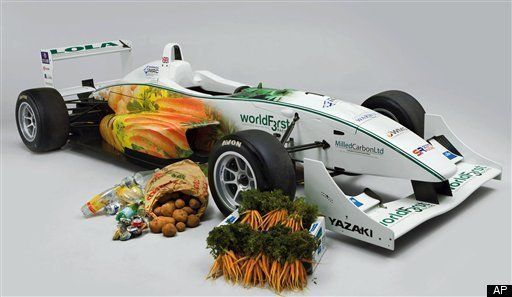
The following is a guest post by Chelsea Green's Makenna Goodman:
I remember a time when defenseless kids with hippie moms got made fun of for using wax sandwich bags (ehem). I remember a time when it was considered uncool to be packing carrot sticks in your tote bag. When yoga was what the weird naked guys did at the hot springs in Ouray, Colorado; you know downward-facing dogs splayed out by the pool. I remember a time, in other words, when trendy things used to be not-trendy. Like BIODIESEL. The wave of the future.
You've seen it station wagons clanking around town with a sign on the back window that says, "This Vehicle Runs on Veggie Oil I'm Awesome." You probably drive by and think: Damn. Those hippies are self-important, but I'm repressing the fact that I want to be just like them. What is wrong with me? But here's the first thing you should know about biodiesel: It's not just white people with dreads who use vegetable oil to run their cars. It's a movement. Dude, my boss does it.
Know this:
*Biodiesel can be made from virtually any vegetable oil
*It can be used in any modern diesel engine
*It's America's fastest growing alternative fuel
But really, biodiesel is a tricky thing to understand, which is why many people just plain don't. Consider it worth your while to get versed on biodiesel, from the experts. And everything you need to know, Greg Pahl will tell you. He's the author of Biodiesel: Growing a New Energy Economy and The Citizen-Powered Energy Handbook: Community Solutions to a Global Crisis and knows the deal.
The following is an excerpt from The Citizen-Powered Energy Handbook: Community Solutions to a Global Crisis by Greg Pahl. It has been adapted for the Web.
Biodiesel 101
Biodiesel, a diverse group of diesel-like fuels, can be easily made through a simple chemical process known as transesterification from virtually any vegetable oil, including (but not limited to) soy, corn, rapeseed (canola), cottonseed, peanut, sunflower, mustard seed, and hemp. But biodiesel can also be made from recycled cooking oil (referred to as "yellow grease" in the rendering industry) or animal fats. One Vietnamese catfish processor is even using fish fat as a biofuel feedstock. There have even been some promising experiments with the use of algae as a biodiesel feedstock. As long as the resulting fuel meets the American Society for Testing and Materials (ASTM) biodiesel standard (D-6751), it's considered biodiesel in the United States, regardless of the feedstock used in its manufacture (in Europe, the standard is EN 14214). And the process is so simple that biodiesel can be made by virtually anyone, although the chemicals required (usually lye and methanol) are hazardous, and need to be handled with extreme caution.
Simply stated, here is how biodiesel is made. The transesterification process is initiated by adding carefully measured amounts of alcohol (methanol) mixed with a catalyst (sodium hydroxide lye the same chemical used to unclog kitchen or bathroom drains) to the vegetable oil. The mixture is stirred or agitated (and sometimes heated) for a specific length of time. If used cooking oil is the feedstock, the process requires a bit more testing, lye, and filtration, but is otherwise essentially the same. During the mixing, the oil molecules are split or "cracked" and the methyl esters (biodiesel) rise to the top of the settling/mixing tank, while the glycerin and catalyst settle to the bottom. After about eight hours, the glycerin and catalyst are drawn off the bottom, leaving biodiesel in the tank. The whole idea of the process is to remove the thick, sticky glycerin from the vegetable oil, so the remaining biodiesel will flow easily and combust properly in a modern diesel engine without leaving damaging deposits inside the engine.
In most cases the biodiesel needs to be washed with water to remove any remaining traces of alcohol, catalyst, and glycerin. In this procedure, water is mixed with the biodiesel, allowed to settle out for several days, and then removed. The wash process can be repeated if needed, but it is time-consuming. Not everyone agrees on whether the water wash is necessary. A few smaller producers who are making biodiesel for themselves skip the process, while commercial producers usually must do it to meet industry standards. In the case of some larger, more sophisticated manufacturing facilities, the transesterification process itself is so carefully controlled and refined that the water wash is not needed. There are, of course, quite a few technical variations on this entire process for large-scale industrial operations, but the general transesterification procedure is similar.
As the amount of biodiesel being produced grows exponentially, the quantities of glycerin by-product grows apace. Glycerin has always been a niche market that is highly sensitive to oversupply, and the recent exponential growth of this commodity as a result of biodiesel production has caused the world glycerin market to collapse. As a result, traditional glycerin manufacturing plants around the world have been closing, while new ones that use glycerin as feedstocks for epoxy resins, propylene glycol, and other products have been opening. Recently, glycerin has even been used by one California company, InnovaTek Inc., as a source for the production of hydrogen. Trying to develop new uses for glycerin has been keeping a lot of people awake at night.
Notes
- "Vietnam firm to make biofuel from catfish fat," Reuters, July 4, 2006, http://www.planetark.com/dailynewsstory.cfm/newsid/37105/story.htm.
- This description of biodiesel basics and some of the other biodiesel-related material that follows is adapted from my Biodiesel: Growing a New Energy Economy.
- InnovaTek, "InnovaTek Inc. and Seattle BioFuels, Inc. announce the first successful production of hydrogen from 100% biodiesel in a microchannel steam reformer," March 14, 2006, http://www.tekkie.com/news/press_release_3-14-06.htm.